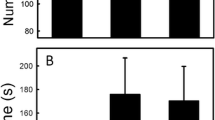Abstract
The locomotory response to cell surface compounds extracted from two prey species,Vibrio natriegens andVibrio neries, was tested for a bacterivorous ciliate,Pseudochnilembus marinus Thompson 1966. Chemoattraction of the ciliate to the surface compounds stabilized in agarose baits was not equal for the two prey species. Fractionation of the extracts suggested the attractive substance was a high molecular weight compound. The expression of the differential response was dependant on the physiological condition and prior prey species exposure of the ciliate test population. The recognition and response to material normally found on the surface of prey cells supports evidence for the involvement of chemical sensing of gradients of prey particles and dissolved compounds of prey origin in the natural swimming behavior of bacterivorous ciliates. The prey species-specific reactions and influence of ciliate physiological state on chemosensory response suggest ciliate-bacteria interactions may be more complex than preciously assumed.
Similar content being viewed by others
References
Almagor, M., A. Ron & J. Bar-Tana, 1981. Chemotaxis inTetrahymena. Cell Motil. 1: 261–268.
Antipa, G. A., K. Martin & M. T. Rintz, 1983. A note on the possible ecological significance of chemotaxis in certain ciliated protozoa. J. Protozool. 30: 55–57.
Bragg, A. N., 1936. Selection of food inParamecium trichium. Physiol. Zool. 9: 433–442.
Buskey, E. J. & D. K. Stoecker, 1988. Locomotory patterns of the planktonic ciliateFavella sp.: adaptations for remaining within food patches. Bull. Mar. Sci. 43: 783–796.
Cavanaugh, G. M. ed., 1956. Formulae and Methods VI of the Marine Biological Laboratory Chemical Room. MBL, Woods Hole, MA, 84 pp.
Doughty, M. J. & S. Dryl, 1981. Control of ciliary activity inParamecium: an analysis of chemosensory transduction in a eukaryotic unicellular organism. Prog. Neurobiol. 16: 1–115.
Fenchel, T., 1969. The ecology of marine microbenthos IV. Structure and function of the benthic ecosystem, its chemical and physical factors and the microfauna communities with special reference to the ciliated protozoa. Ophelia 6: 1–182.
Fenchel, T. & P. R. Jonsson, 1988. The functional biology ofStrombidium sulcatum, a marine oligotrich ciliate (Ciliophora, Oligotrichina). Mar. Ecol. Prog. Ser. 48: 1–15.
Fisher, E. S. & D. A. Lauffenburger, 1987. Mathematical analysis of cell-target encounter rates in two dimensions. The effect of chemotaxis. Biophys. J. 51: 705–716.
Forsberg, C. W., J. W. Costerton & R. A. MacLeod, 1970. Separation and localization of cell wall layers of a Gram-negative bacterium. J. Bact. 104: 1338–1353.
Hellung-Larsen, P., V. Leick & N. Tommerup, 1986. Chemoattraction inTetrahymena: on the role of chemokinesis. Biol Bull. 170: 357–367.
Jackson, G. A., 1989. Simulating chemosensory response of marine microorganisms. Limnol. Oceanogr. 32: 1253–1266.
Jennings, H. S., 1906. Behavior of Lower Animals, Indiana University Press, Bloomington.
Leick, V., 1988. Gliding inTetrahymena thermophila: oriented chemokinesis in a ciliate. Eur. J. Protistol. 23: 354–360.
Leick, V. & J. Helle, 1983. A quantitative assay for ciliate chemotaxis. Anal. Biochem. 135: 466–469.
Leick, V. & P. Hellung-Larsen, 1985. Chemosensory responses inTetrahymena: the involvement of peptides and other signal substances. J. Protozool. 32: 550–553.
Levandowsky, M. & D. C. R. Hauser, 1978. Chemosensory responses of swimming algae and protozoa. Int. Rev. Cytol. 53: 145–210.
Levandowsky, M., T. Cheng, A. Kehr, J. Kim, L. Gardner, L. Silvern, L. Tsang, G. Lai, C. Chung & E. Prakash, 1984. Chemosensory responses to amino acids and certain amines by the ciliateTetrahymena: a flat capillary assay. Biol. Bull. 167: 322–330.
Lindstedt, K. J., 1971. Chemical control of feeding behavior. Comp. Biochem. Physiol. 39(A): 553–581.
Loeb, M. R., J. Kilner, 1979. Effect of growth medium on the relative polypeptide composition of cellular outer membrane and released outer membrane material inEscherichia coli. J. Bact. 137: 1031–1034.
Machemer, H., 1988a. Electrophysiology. In H.-D.Gotz (ed.),Paramecium. Springer-Verlag, Berlin, FRG., pp 185–215.
Machemer, H., 1988b. Motor control of cilia. In H.-D. Gortz (ed.),Paramecium. Springer-Verlag, Berlin, FRG., pp 216–235.
Metalnikov, M. S., 1914. Les infusoires peuvent-ils apprendre a choisir leur nourriture? Archiv Protistenk. 34: 60–78.
Nast, C. C. & L. E. LeDuc, 1988. Chemotactic Peptides, mechanisms, functions, and possible role in inflammatory bowel disease. Digest. Diseas. Sci. 33: 50S-57S.
Nelson, J. D.Jr. & R. A. MacLeod, 1977. Distribution of lipopolysaccharide and detection of a new subfraction in the cell envelope of a marine Pseudomonad. J. Bact. 129: 1059–1065.
Rasmussen, L. & T. A. Klut, 1970. Particulate material as a prerequisite for rapid cell multiplication inTetrahymena cultures. Exp. Cell. Res. 59: 457–463.
Roberts, R. B., P. H. Abelson, D. B. Cowrie, E. T. Bolton & R. J. Britten, 1963. Studies of Biosynthesis inEscherichia coli. Carnegie Institution Publication 607, 521 pp.
Rollins, D. M., J. C. Collbaugh, R. I. Walker & E. Weiss, 1983. Biphasic culture system for rapidCampylobacter cultivation. Appl. envir. Microbiol. 45: 284–289.
Snyder, R. A. & E. B. Small, 1984. The response of protists to spatial heterogeneity produced by a gradient culture technique. J. Protozool. 31: 21A.
Tanabe, H., K. Kurihara & Y. Kobatake, 1980. Changes in membrane potential and membrane fluidity inTetrahymena pyriformis in association with chemoreception of hydrophobic stimuli: fluorescence studies. Biochemistry 19: 5339–5344.
Thompson, J. C., 1966a.Pseudocohnilembus marinus n. sp., a Hymenostome ciliate from the Virginia Coast. J. Protozool. 13: 443–465.
Van Houten, J. & R. R. Preston, 1988. Chemokinesis. In: H.-D. Gortz (ed.),Paramecium. Springer-Verlag, Berlin, FRG., pp 282–300.
Verity, P. G., 1988. Chemosensory behavior in marine planktonic ciliates. Bull. Mar. Sci. 43: 772–782.
Wimpenny, J. W. T., J. P. Coombs & R. W. Lovitt, 1984. Growth and interactions of microorganisms in spatially heterogeneous ecosystems. In M. J. Klug & C. A. Reddy (eds.), Current Perspectives in Microbial Ecology, ASM, Washington, D.C., pp 291–299.
Author information
Authors and Affiliations
Rights and permissions
About this article
Cite this article
Snyder, R.A. Chemoattraction of a bactivorous ciliate to bacteria surface compounds. Hydrobiologia 215, 205–213 (1991). https://doi.org/10.1007/BF00764855
Received:
Revised:
Accepted:
Issue Date:
DOI: https://doi.org/10.1007/BF00764855




